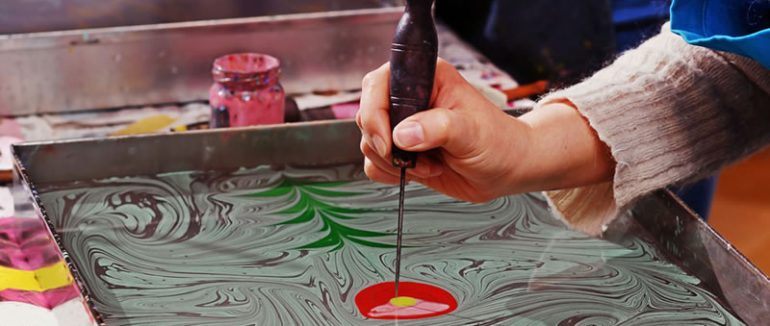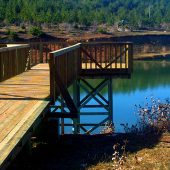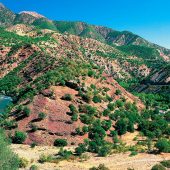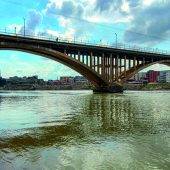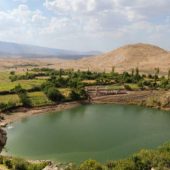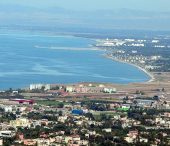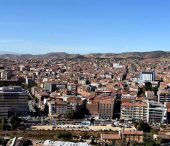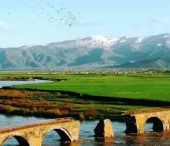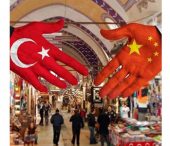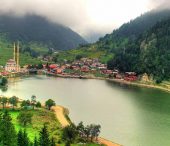Ebru is a traditional Turkish art of paper decoration by spreading paints, which do not dissolve in water, with brushes made of horse hair and rose wood on dense water that is thickened by gum-tragacanth.
The word Ebru origin comes from Persian language (Ebri-eyebrow or Ab-ru-face of water) Ebru in Turkish which means marbling. It isn't known exactly when or where Ebru art started but the early examples are from the 16th century in the Ottoman-Turkish era and spread from the east to the west by way of Silk Road and other trade routes same as like paper.
For centuries, Ebru was an art form found only inside the covers of books. The basic technique which, throughout all its historical variations, has never changed. The process is always the same: paints are made to float on the surface of water where they are manipulated into designs and then transferred to a sheet of paper. In order to make this happen, the artist must learn to control the behaviour of the paint. Ebru artists knowledge and skills, as well as the philosophy behind this art, are transmitted orally and through informal practical training within master-apprentice relationships. Achieving basic skills in Ebru takes about two years.
Ebru was listed in 2014 by UNESCO on the Representative List of the Intangible Cultural Heritage of Humanity.
MATERIALS USED IN EBRU ART
Ebru Paints: Natural colours are used for centuries, which are gained from coloured rocks and earth that contains oxidised metals or organic pigment colours that do not dissolve in water.
Tragacanth: There are different ways to obtain a concentrated and adhesive liquid for ebru art. Most commonly used are the Tragacanth and seaweed. Tragacanth is a type of natural gum resin found in Anatolia. It is used in medicine, cosmetics, and textile sectors.
Ox Gall: In order to have ebru colours to spread on the surface of the liquid and to prevent them from sinking ox gall is using. which is a surface active substance, breaking and regulating the surface tension. It also stops colours from blending.
Tray: A tray is used to contain the liquid for ebru-making. It is made of steel. Rectangular trays have a depth of approximately 5-7 cm. The most widely used sizes are 35 x 50cm, 50 x 70 cm, size A2 and size A3.
Brushes: Old horses' hair and dried rose stalk are used to make ebru brushes. Horse hair is preferred, because it is thick and straight, so that you can splatter paint in a desired way. It also prevents bacterias and mold from multiplying and growing. Rose stalk are flexible and durable.
Comb: Combs are used to making combed designs.
Awl: Awls are made of nails, strings and needles of various size and thickness. They are used for dropping and shaping ebru colours afloat on the surface. It is important that they are made of stainless steel.
Paper: Any kind of absorbent paper which is not lacquered or polished may be used in Ebru.
EBRU TYPES
Battal: Stony It is the oldest known pattern in ebru. There are also variations of the Battal designs. Colors are simply applied with a brush without using a comb or an awl.
Gel Git; Tides Gel Git pattern is made using an awl and by drawing parallel lines in a back-and-forth manner on a battal ebru. It can be either vertical or horizontal.
Şal; Shawl Over a Gel Git ebru, drawing wavy or diagonally lines to get a shawl design.
Bülbül Yuvası; Nightingale's Nest On a Battal pattern from out to in drawing spirals. Classically spirals repeated in all over tray size 4x5 times. This type ebru can be applied on Combed or Gel Git patterns.
Taraklı; Combed This pattern is obtained by applying a comb.
Hafif; Light The size for this type of ebru must be less concentrated and the colours must contain more water and ox gall than other types.
Dalgalı; Wavy Shifted design can be applied over any other design. When placing the paper, instead of laying it down smoothly, we gradually slide it on the surface to have an effect of shaded lines. It is also called Spanish marbling.
Kumlu; Sandy To obtain this pattern, the paint dropped the centre of the tray and repeat the same process until all the surface of the water is covered and the drops squeezed each other and start to crack.
Çift Ebru; DoubleOvermarbling Created by applying another layer of ebru over a marbled paper.
Akkase Ebru; (Stenciled Ebru) This is a pattern obtained by making several imprints on the same background, and popular with calligraphers. The base consists of a "light ebru" upon which the script is written using a special fluid prepared with gum arabic applied with a brush.
Hatip It consists of concentric shapes of several colours formed one inside the other and can be acclaimed as the foundation of flowery ebru. First, one of the ebru patterns is set as background. On this background equidistant circles of 2-4 cm diameter are set by using a bradawl or dropper. Generally, the first colour is dark. Later, the second, third or even fourth colour is set. Then the design is formed by using a fine point, needle or bradawl.
Flowery This is a style of Ebru developed by the late master Necmeddin Okyay (1883-1976). This type of marbling has helped the art of ebru to take place among other plastic arts. Any type of ebru is set as background. Usually, a light coloured ebru pattern is chosen. On top of this base, the drops of paint are designed into the shape of leaves and flowers with the help of a bradawl. The flowers that have been generally designed are tulips, carnations, hyacinths, violets, daisies and roses.

